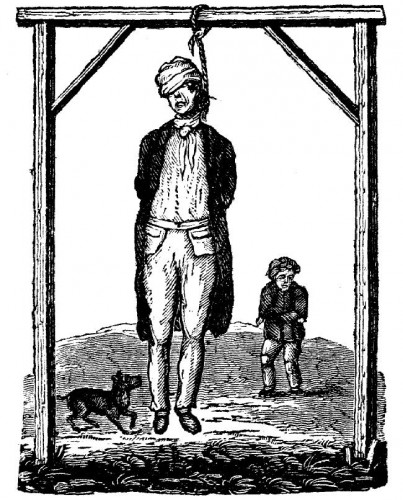Brooklyn’s status as county seat in 1831 resulted in the town hosting what is widely accepted as the last public hanging in Connecticut. A jury convicted Oliver Watkins, a local man perhaps driven to murder by a “temptress” named Waity Preston, of strangling his wife Roxana on the night of March 22, 1829. They sentenced Watkins to hang on August 2, 1831.
At the time of Watkins’s conviction, public hangings were still a regular and accepted part of early American life. In addition serving as punishment for the convicted, they acted as a macabre form of entertainment for the community. Large crowds of men, women, and even children gathered at the scaffold to cheer, joke, and taunt the condemned. Authorities believed that allowing the populace to watch criminals pay for their offenses acted as a deterrent that helped keep the peace—even if the events themselves often degenerated into raucous excuses for drinking and brawling.
For the execution of Oliver Watkins, several thousand people arrived in Brooklyn to see him hang. Local tavern keepers even paid a guard to watch over Watkins and make sure he did not escape or commit suicide—potentially cutting into their anticipated alcohol sales. In this almost festive atmosphere, Watkins met his fate, after which the crowd continued their celebration.
Public Executions Reconsidered
By the time of Watkins’s hanging, however, attitudes about the death penalty and public executions began to change. Due, in part, to the spread of Enlightenment ideals, citizens began viewing public executions as barbaric and degrading. To help counter their ritualistic appeal, authorities started limiting the number of spectators allowed to view public executions.
In addition, the beginning of the 19th century saw an explosion in the growth of prisons. Rapid urbanization and industrialization changed the way people viewed law breakers. Crime became less about sin and more about preventing violence and the loss of property. It was also during this time that reformers successfully lobbied for more humane treatment for criminals. Incarceration became the preferred solution to the dilemma of how to punish law breakers. Through the use of incarceration, different sentence lengths could be made to match varying offenses. This new awareness of human rights and the development of the US penal system helped ensure that public and humiliating executions ended in Connecticut.









